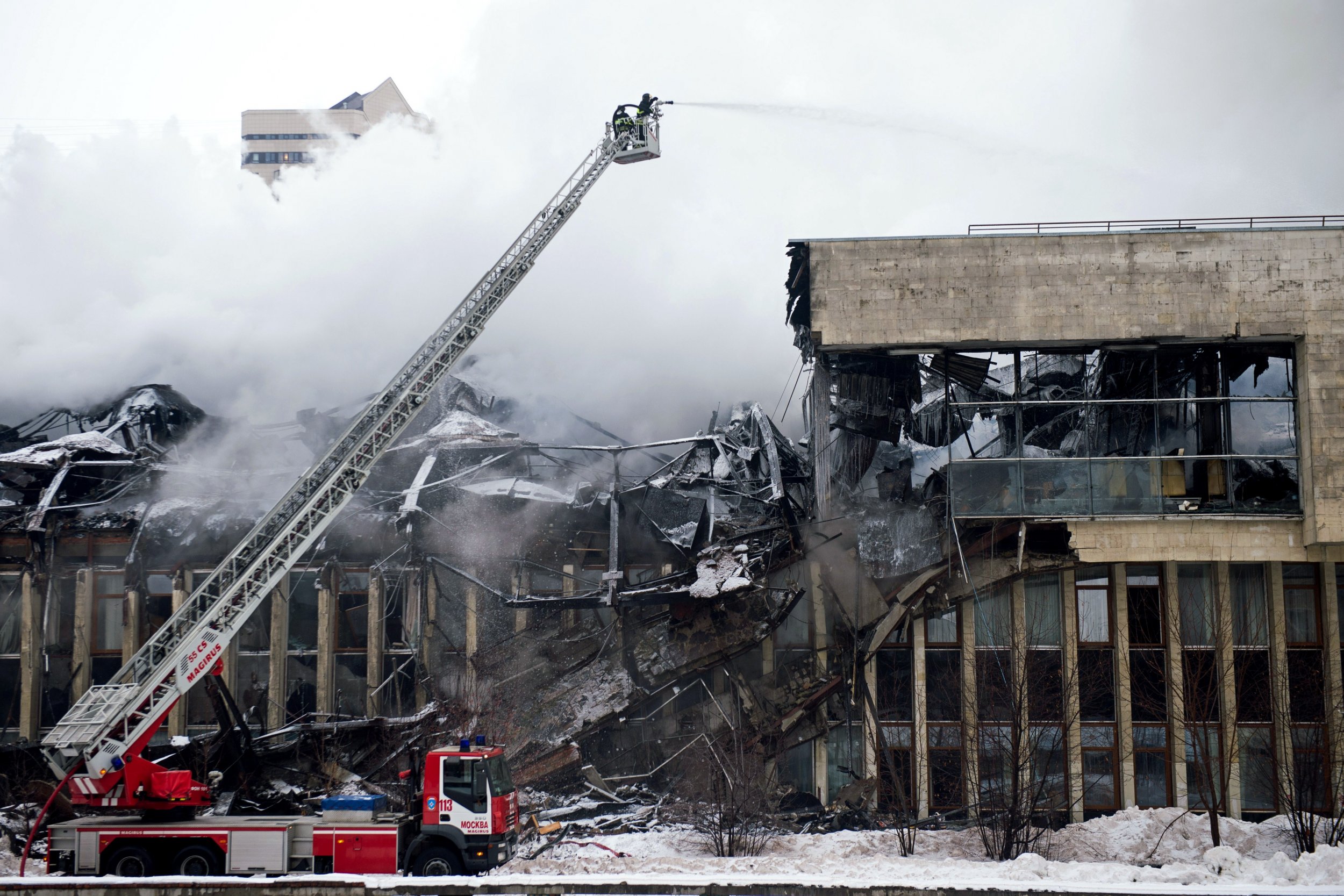
After a huge fire at Russia's Institute of Scientific Information on Social Sciences in Moscow was finally extinguished on Saturday, a long process began: salvaging books and collections damaged by flames, smoke and the water used by firefighters.
Though experts in the U.S. said they were not yet familiar with the specifics of the blaze at the Soviet-era building, they spoke with Newsweek about the precautions that such libraries and archives can take in case of disaster and what happens afterward when conservators are trying to rescue damaged materials.
The current standard procedure for salvaging books and collections damaged by water calls for the materials to be frozen as soon as possible. That's right: Stick them in a freezer.
"The material needs to be packed into cartons and frozen to stop the deterioration," says Duncan Rioch, a project administrator at Document Reprocessors, a company that specializes in salvaging water- and smoke-damaged books, documents and other archival material.
Previously, the company has been charged with restoration efforts for the Library of Congress and the Smithsonian. Most famously, it helped salvage and preserve the documentation that came up from the Titanic. While Rioch explained the process to Newsweek on Monday, one of the company's staffers was en route to Brooklyn, where a fire that broke out Saturday morning ravaged a warehouse full of New York City agency records.
Frances Harrell, a preservation specialist at Northeast Document Conservation Center, says libraries and archives should install automated fire-suppression systems, like sprinklers, because water-damaged records "are recoverable. We like them wet better than we like them burned up." But the mold that can result from the wet paper can be extremely harmful, she adds.
Paper and other porous materials grow when wet and can therefore break bindings on books. Once the materials are frozen, though, they can be kept indefinitely until the institution is ready to continue the restoration process. A vacuum freeze dryer can then evaporate the ice out of the material without allowing it to go through a liquid state. In other words, the technique uses sublimation, which means the ice changes from a solid state directly to a gaseous state. The vacuum helps speed up the process.
Document Reprocessors also has an alternative cryogenic drying method that takes three or four weeks, rather than the seven to 14 days for vacuum freeze drying, but allows the company to dry leather and ancient documents without having them crack. Since the process is proprietary, Rioch said he couldn't reveal the details.
Once the documents are dry, they need to be assessed for damage caused by the water, or the smoke or fire that came before the water, Rioch explains. For example, water damage can cause the glue from book bindings to migrate onto the pages, so they need to be carefully separated.
When fire is involved, there can be an accumulation of soot on the material, and the water can carry it into the material. Because soot can contain creosote, a carcinogen, the book or document "needs to be surface-cleaned and encapsulated to preserve the historical document in a manner that it is still safe for people to handle," Rioch says. Sometimes in these situations, an organization will prefer to scan and index the contents for reference and encapsulate the full item in plastic, rather than encapsulating each individual page (with lamination, for example).
Harrell cited the 1973 fire at the National Archives' National Personnel Records Center in St. Louis and a devastating 2009 fire at the Historical Archive of Cologne in Germany, which led to that building's collapse, as other examples comparable to last week's events in Moscow. But fire is not as common as flooding and water damage, says Rioch, who adds that his company is working with many municipalities that are still recovering documents damaged during Hurricane Sandy. In any case, both fires and floods lead to water damage.
Vladimir Fortov, president of Russia's Academy of Sciences, compared the Moscow institution that caught fire Friday with the Library of Congress (LOC). So what would the Library of Congress do if its collections were damaged?
Elmer Eusman, chief of the conservation division, says the LOC has three main lines of defense in case of such an emergency. First is a so-called "beeper team"—which now uses iPhones—of about a dozen members, who are on a standby rotation to alert higher powers in case of a water breach or another situation. Second, the library has a designated space with equipment and supplies ready to salvage its collections.
When there's an emergency, there's "always a sense of panic," says Eusman. "You don't want to be thinking about what you need, you want it all already handy." The supplies and equipment include pads that soak up large quantities of water, boards to keep covers straight while drying, personal protective gear, freezer storage and a vacuum freeze dryer that can handle small quantities of materials.
Finally, the LOC has a contract agreement in place with a company that, like Document Reprocessors, can contribute manpower, supplies and equipment in larger emergencies.
The response part of a disaster, like putting materials in the freezer, "can happen very quickly and is relatively cheap," says Eusman. But that's just the first step. The recovery that follows is often slow and very costly.
Based on photographs he's seen in the news of the fire in Moscow, "it'll be a significant amount of damage," he says. "There's going to be irreparable loss, undoubtedly, but I'm sure some will be recoverable."
Uncommon Knowledge
Newsweek is committed to challenging conventional wisdom and finding connections in the search for common ground.
Newsweek is committed to challenging conventional wisdom and finding connections in the search for common ground.
About the writer
Stav is a general assignment staff writer for Newsweek. She received the Newswomen's Club of New York's 2016 Martha Coman Front ... Read more





